The rain came pounding down overnight as if we were under a waterfall with the tropical foliage blasted by light from the nearby lightning. It was a tropical welcome along with an experience neither Andrea nor I could have imagined. On a moonless night with the cicadas crescendoing in the forest, we at different times awoke within our tent, to be met with absolute, black nothingness. We couldn’t see our our hands before our faces. One’s first fleeting thought is that you’ve gone blind, but in reality, it was the absolute absence of any kind of light.
Question: Why are clay licks so important to parrots and macaws?
With morning light we were up, and Chino the Waorani “chef” offered up coffee, followed by a type of yogurt that resembles kefir, fresh fruits such as bananas, a type of mango and dragon fruit. Each morning we had eggs often with fried manioc (cassava). Then, it was off in the panga (canoe) up river some 45 minutes catching site of numerous species of monkeys including, Howlers, Woolies,Squirrels, Sakis and Spiders. The bird species were too many to fully appreciate but I would be lax not to mention the Toucans, Scarlet, Blue and Gold Macaws, and the ever present Oro Pendola with their long, vertical, woven nests that can frequently be seen gracing the larger trees.
We beached the Panga, and began our trek decked out in tall rubber boots (due to extremely muddy conditions but also as a preventative to snake bites). Along the trail Otobo would stop and educate us about the tropical plants and their cultural and medicinal uses. Some examples were the Ayahuasca
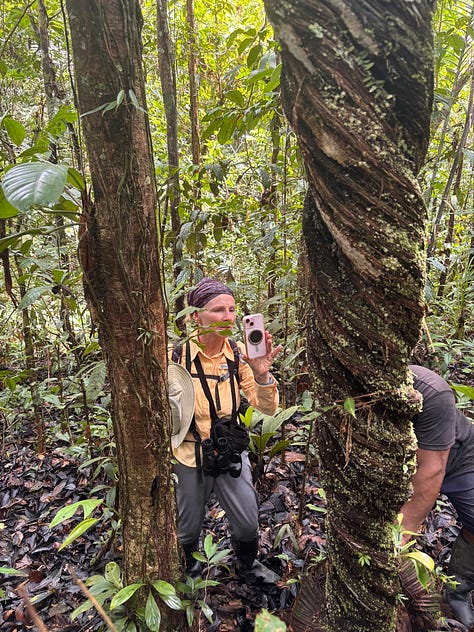
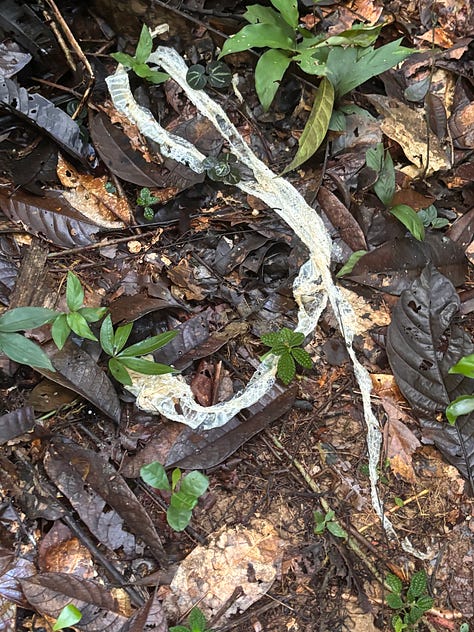
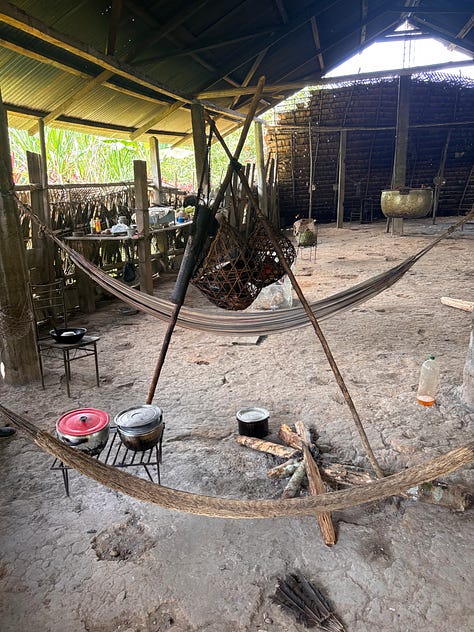
tree which provides a hallucinogen preferred by the tribes’ shamans. This strange looking vine forms what appears to be a twisted tree ( corkscrew like) and is relatively rare in the jungle. Numerous edible roots were shown to us that cure intestinal maladies, and leaves of a particular plant which are waved over the body by shamans to eliminate bad spirits. Along the way we passed a rotting Jaguar trap composed of horizontal and vertical stakes that originally had a trap door. A live fowl was tied down within, and the Jaguars would enter, and with the trap door sprung, would be found the next day.
While crossing a wonderfully clear stream that eventually would feed the Cononaco river, we came upon an oft deadly fresh water stingray, some four foot from tip to barbed tale. The ray was so well camouflaged in the same hue as the clay silt bottom, that I could not even see it below the surface, perhaps one foot, for an extended period of time. It wasn’t until Otobo disturbed it slightly with a stick that it swam downstream and out of sight, thus allowing us passage. After a 1.5 mile hike through the steamy underbrush, we were assaulted by a cacophony of screeches emanating from the high canopy. The macaws were telling us to f**k off in so many screeches. We knew were were approaching our destination, a clay lick. Quietly, we all approached an opening on the forest floor perhaps 20 feet wide and 50 feet long. The area was blanketed in boot sucking mud and had small caves in the sidewalls across from us. To our dismay, the clay lick was absent any macaws or parrots; only one bird present. Dominating this clay lick was a formidable looking black bird, standing about 2 feet high, perusing his surroundings, a Salvins Currasow. This rare species of bird (Mitu salving) stood out with his large black body, red bill and white lower belly. Alone, he kept the macaws and parrots at bay, precluding them from visiting this nutritionally important site, tucked deep in the primordial jungle.
We returned to the panga, and marveled once again at the skin of a Bushmaster snake we had passed on the way in. The Bushmaster is in the viper family of snakes and is considered one of the deadliest snakes in the world due to the rapidity of it’s strikes and the volume of venom that can be delivered in one bite. It can kill virtually anything in its path and comes in at 6 to 11 pounds when fully grown. We were actually pleased to see his skin, and not to have encountered this particular viper. After eating a large meal, the Bushmaster will digest for a week or so, growing all the while then shedding his skin to allow his larger self to begin the hunt anew.
The highlight the following day was a visit to Otobo’s (Otobo being our Waorani guide) parents about an hour upstream from the basecamp. After navigating a small tributary of the Cononaco we beached the panga, walked up a short embankment and observed a low slung, relatively modern house sitting on stilts. Long story short, after Otobo’s brother was killed by Taegeri (see previous post), he bought a number of shotguns and set out to hunt the offending Taegeri and eliminate them. The Ecuadorian government got wind of his plans, and put him in jail preemptively, finally reaching a financial settlement with Otobo to cease all plans for retribution. From these funds he built this home for his parents and another brother. These Taegeri inhabit was is now characterized as the Intangible Zone.
Next to the modern house in the same clearing, cut from the jungle, stood a large (50 by 40 foot) wooden structure composed of hand hewn logs supports and a pandanus leaf roof. In the darker interior we found Otobo’s sister and brother in law sitting in their two hammocks by an open fire. Otobo proudly showed us his blowgun made from a special type of bamboo. This hunting device is about six foot in length, oval in shape with the outside protected by the twisted filaments of a vine. Once outside, he set up a pineapple that he found on a stump, and from 40 feet away, put a bamboo dart solidly in the middle of the pineapple. We were all impressed with this accuracy, the more so then when we tried it ourselves. First off, the blowgun must weight in over 10 pounds, which then requires considerable arm strength to keep it horizontal and on target. Andrea was not able to hold it up, our Kitchwa guide Edwin successfully shot the blowgun but missed the target, and my dart fell two feet in front of the target (read inadequate lung volume). Blowguns are still used today to hunt monkeys for food when other sources of food wane. This is usually done by a party of 4-6 men who venture into the jungle naked, armed only with their exceptional sensory systems that are tuned to the sounds of the jungle and a blowgun.
Otobo showed how the dart is fitted with a cottony wad from the Kapoc tree that provides the seal necessary for the dart to move with force through the blowgun. Additionally, the tip of the bamboo dart is scored using the intact jaw teeth of the Piranha fish, then the scored tip has curare (a poison that is a quick muscle relaxant) applied to it in crystal form. Soon after an animal is hit, the curare incapacitates their muscles and they fall to the ground. After the blowgun exhibition, we were introduced to Otobo’s parents, two exceptionally small (a little over four feet in stature) individuals with strong physicality at close to 75 years of age. His mother found Andrea charming especially with her blond hair. They both talked a mile a minute while we were there and apparently found us fascinating as we did them.
Answer: Parrots, Macaws and certain mammals whose diet is primarily tropical fruit, build up toxins in their digestive systems from the tropical fruit they consume in quantity. Periodically, from daily to once a week, they must neutralize these toxins or die. The minerals found in the soft clay of the Amazon are the antidote for these toxins. These clay licks paradoxically also become the hunting grounds for predators such as the Jaguar, who instinctually know that certain species must consume the clay at these licks, thus presenting themselves as prey.
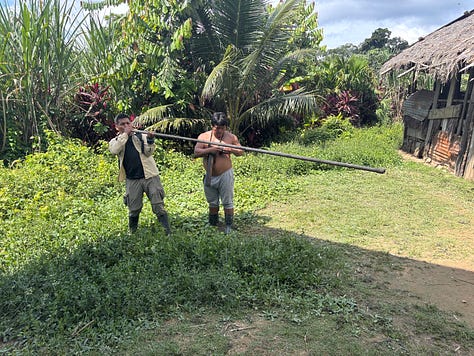
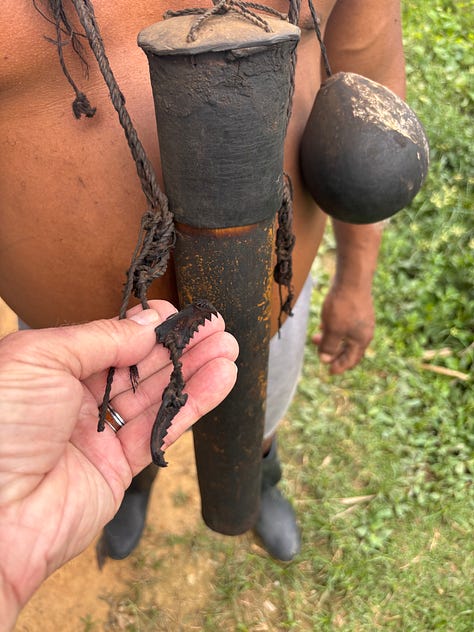
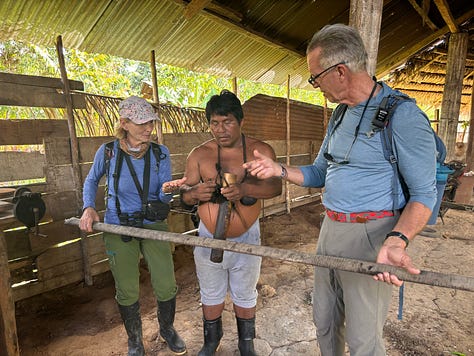



Karen, thanks so much for your comment. All the best.
If you are still in Ecuador you should check out Pigmy Marmosets found in that country. Only 5" long and less than a pound in weight. Cover story in this month's Smithsonian Mag. Absolutely darling. You might find world's longest snake along with world's smallest monkey.
GO FOR IT